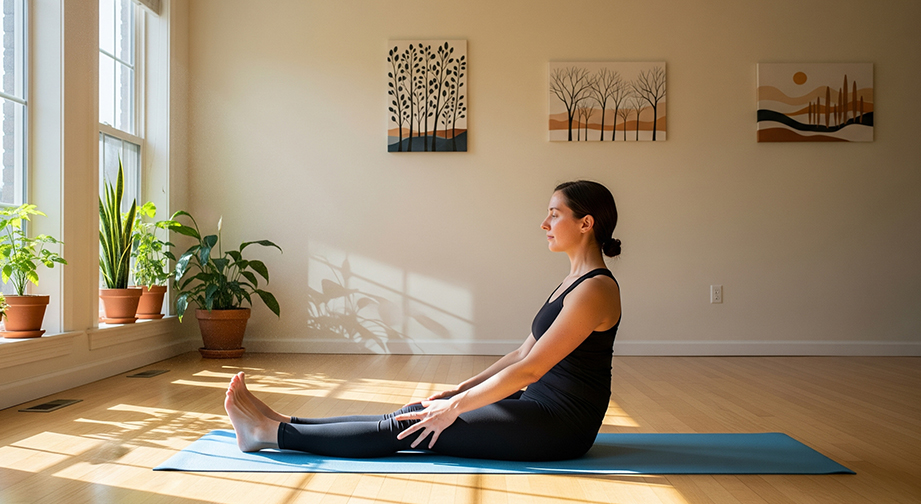Dandasana (Staff Pose): Step-by-Step Guide, Benefits, and Tips
Introduction
Dandasana, pronounced DAHN-DAH-sa-nuh, is a foundational seated yoga posture known as Staff Pose. In Sanskrit, danda means "staff" or "stick," symbolizing strength and uprightness, while asana means "pose." The essence of this pose is balancing—bringing stability and length to the spine while cultivating mindfulness.
If you've ever felt stiff after sitting at your desk all day, Dandasana is your new best friend! This simple yet effective pose is the starting point for many other seated yoga asanas, making it perfect for beginners.
Step-by-Step Guide: How to Practice Dandasana (Staff Pose)

- Sit with Legs Extended: Begin seated on your mat, legs stretched out straight in front of you. Keep your feet together and flexed, toes pointing up.
- Ground the Sitting Bones: Gently move the flesh of your buttocks aside so both sitting bones are evenly pressing into the mat.
- Align the Spine: Sit up tall. Imagine a line of energy extending from your tailbone through the crown of your head. Draw your navel lightly in toward your spine.
- Place Your Hands: Place your palms on the mat beside your hips, fingers pointing forward. Press down gently to keep your torso upright.
- Relax the Shoulders: Roll your shoulders back and down away from your ears.
- Gaze Forward: Keep your chin level and gaze soft, looking straight ahead.
Breathing Pattern:
Inhale deeply as you lengthen the spine. Exhale as you relax your legs and shoulders. Maintain a smooth, natural breath throughout the pose.
- Duration: Hold for 30-60 seconds, repeating 2-3 rounds if comfortable.
Modifications for Beginners
- Sit on a folded blanket or yoga block for support, especially if your lower back rounds or hamstrings feel tight.
- Bend your knees slightly or place a rolled towel under them for less strain.
- Use a yoga strap looped around the soles of your feet to help keep your spine tall.
Intensifications for Advanced Practitioners
- Keep the legs straight and actively press the thighs and calves into the floor.
- Engage the core muscles and draw the kneecaps upward.
- Integrate subtle lifts at the sternum for increased spinal energy.
Alignment & Safety Tips
- Lengthen the spine—avoid slouching or rounding the lower back.
- Flex the feet, pressing heels and the backs of thighs into the mat.
- Keep shoulders relaxed, not tense or hunched by your ears.
Common Mistakes & How to Avoid Them:
- Rounding the lower back ? use a prop or bend knees to support upright posture.
- Locked or hyperextended knees ? keep a micro-bend if needed.
- Collapsing chest ? engage core and press into the ground for lift.
Safety Precautions:
- Avoid if you have recent or severe back, hip, or arm injuries.
- Pregnant yogis or those with sciatica should practice only with guidance or choose alternatives.
Benefits of Dandasana (Staff Pose)
Physical Benefits
- Improves posture and spinal alignment
- Strengthens back, shoulders, and core
- Stretches hamstrings and calves
- Prepares the body for deeper yoga asanas
Mental Benefits
- Encourages mindfulness and present-moment awareness
- Calms the mind, reducing stress and anxiety
- Helps develop patience and focus
Energy / Chakra Connection
- Activates the Muladhara (Root) Chakra, promoting grounding and emotional stability
- Supports energetic alignment through the spine
Contraindications
- If you have chronic back pain, slipped disc, or hip injuries, practice with caution or avoid the pose.
- Prenatal practitioners: Skip or modify as advised by a prenatal yoga teacher.
- Acute sciatica cases: Avoid Staff Pose, try supported reclined positions instead.
Safe Alternatives:
- Seated Forward Fold with support (Paschimottanasana with bent knees)
- Supported Reclined Mountain Pose (Supta Tadasana)
Beginner's Tips & Variations
Using Props
- Sit on a bolster or folded blanket to help tilt your pelvis forward for a tall spine.
- Press your back gently against a wall for support, especially if new to the pose.
- Use a yoga strap to hold your feet and maintain lift in the torso.
Gentle Variations for Beginners
- Bend your knees or support them with a rolled blanket for comfort.
- Practice Dandasana with hands behind your hips for extra support.
Advanced Variations
How to Include Dandasana in Your Yoga Flow
- Best as a warm-up or transitional pose to establish alignment and connect with your breath.
- Pairs well with:
- Seated Forward Fold (Paschimottanasana)
- Reverse Tabletop (Ardha Purvottanasana)
- Seated Twist (Ardha Matsyendrasana)
Mind-Body Connection
While in Dandasana, focus on each breath and the sensation of your body connecting with the earth. This pose is a powerful way to build awareness—physically, mentally, and energetically. By aligning your body like a strong, grounded staff, you tap into stability and inner calm.
Chakra note: Staff Pose helps energize and balance the Root Chakra, supporting feelings of safety and foundational strength.
Summary: Dandasana (Staff Pose)
- Sanskrit Name: Dandasana (???????)
- Level: Beginner
- Focus Areas: Spine, hamstrings, core, posture
- Duration: 30-60 seconds, 2-3 rounds
- Best Time to Practice: Morning or evening, or whenever you need a posture reset
Frequently Asked Questions (FAQs)
Q: Is Dandasana (Staff pose) good for beginners?
A: Absolutely! Dandasana is designed for all levels and is a fantastic starting posture for new yogis.
Q: Can I practice Dandasana if I have tight hamstrings?
A: Yes, you can bend your knees slightly or use a blanket/strap for support. With regular practice, hamstring flexibility will improve.
Q: Why is Dandasana important?
A: Dandasana is the foundation of all seated postures in yoga. It helps improve alignment, posture, and mindfulness, and prepares you for more advanced asanas.
Q: How often should I include Staff Pose in my practice?
A: For best results, include Dandasana daily or at the start of your yoga routine to set the foundation for other poses.